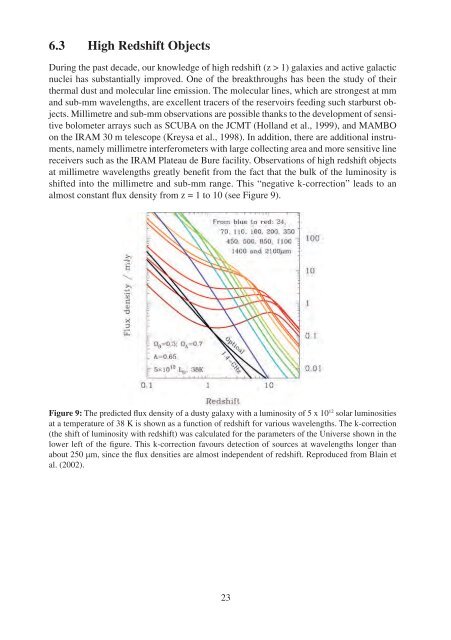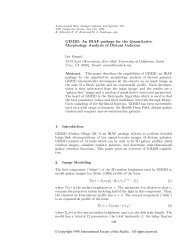4 Comparison of the ALMA and Herschel - ESO
4 Comparison of the ALMA and Herschel - ESO
4 Comparison of the ALMA and Herschel - ESO
Create successful ePaper yourself
Turn your PDF publications into a flip-book with our unique Google optimized e-Paper software.
6.3 High Redshift Objects<br />
During <strong>the</strong> past decade, our knowledge <strong>of</strong> high redshift (z > 1) galaxies <strong>and</strong> active galactic<br />
nuclei has substantially improved. One <strong>of</strong> <strong>the</strong> breakthroughs has been <strong>the</strong> study <strong>of</strong> <strong>the</strong>ir<br />
<strong>the</strong>rmal dust <strong>and</strong> molecular line emission. The molecular lines, which are strongest at mm<br />
<strong>and</strong> sub-mm wave lengths, are excellent tracers <strong>of</strong> <strong>the</strong> reservoirs feeding such starburst objects.<br />
Millimetre <strong>and</strong> sub-mm observations are possible thanks to <strong>the</strong> development <strong>of</strong> sensitive<br />
bolometer arrays such as SCUBA on <strong>the</strong> JCMT (Holl<strong>and</strong> et al., 1999), <strong>and</strong> MAMBO<br />
on <strong>the</strong> IRAM 30 m telescope (Kreysa et al., 1998). In addition, <strong>the</strong>re are additional instruments,<br />
namely millimetre interferometers with large collecting area <strong>and</strong> more sensitive line<br />
receivers such as <strong>the</strong> IRAM Plateau de Bure facility. Observations <strong>of</strong> high redshift objects<br />
at millimetre wavelengths greatly benefit from <strong>the</strong> fact that <strong>the</strong> bulk <strong>of</strong> <strong>the</strong> luminosity is<br />
shifted into <strong>the</strong> millimetre <strong>and</strong> sub-mm range. This “negative k-correction” leads to an<br />
almost constant flux density from z = 1 to 10 (see Figure 9).<br />
Figure 9: The predicted flux density <strong>of</strong> a dusty galaxy with a luminosity <strong>of</strong> 5 x 10 12 solar luminosities<br />
at a temperature <strong>of</strong> 38 K is shown as a function <strong>of</strong> redshift for various wavelengths. The k-correction<br />
(<strong>the</strong> shift <strong>of</strong> luminosity with redshift) was calculated for <strong>the</strong> parameters <strong>of</strong> <strong>the</strong> Universe shown in <strong>the</strong><br />
lower left <strong>of</strong> <strong>the</strong> figure. This k-correction favours detection <strong>of</strong> sources at wavelengths longer than<br />
about 250 μm, since <strong>the</strong> flux densities are almost independent <strong>of</strong> redshift. Reproduced from Blain et<br />
al. (2002).<br />
23




